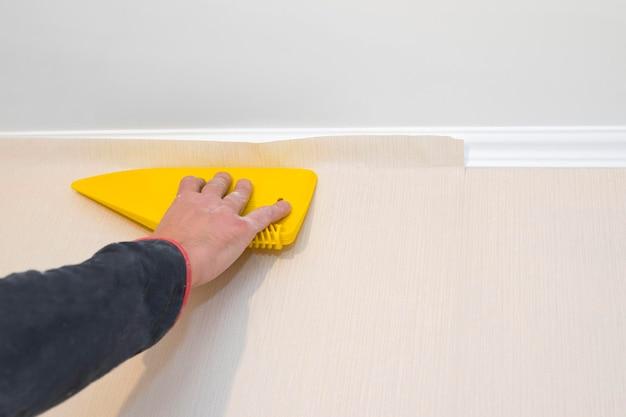Are your plastic baseboards looking worn-out or outdated? Painting them can be a simple and cost-effective way to give your space a fresh, new look. However, if you’ve never painted plastic before, you might have some questions. Do you need to sand the surface? Can you use regular wall paint? And what about priming?
In this comprehensive guide, we’ll walk you through the process of painting plastic baseboards step by step. We’ll answer common questions like whether you need to sand vinyl before painting, what kind of paint will stick to plastic, and if you can use latex paint on plastic. By the end, you’ll have the knowledge and confidence to transform your plastic baseboards into a focal point of your room. So, let’s dive in and bring new life to your baseboards!
How to Give Your Plastic Baseboards a Fresh Coat of Paint
So, you’ve got plastic baseboards, huh? Great choice! They’re durable, low-maintenance, and perfect for keeping your walls looking pristine. But what happens when your baseboards start losing their luster? Fear not, my friend! In this guide, I’ll show you the ropes on how to paint plastic baseboards and give them a fresh lease on life. Get ready to unleash your inner Picasso (or maybe just your handyman skills)!
Gather Your Supplies
Before diving into the colorful world of plastic baseboard painting, it’s essential to arm yourself with the right tools. Here are the things you’ll need:
1. Sandpaper or Sanding Block
Just like any painting project, preparation is key. Start by lightly sanding the surface of your plastic baseboards to create a rough texture. This step helps the paint adhere better, increasing its lifespan. Think of it as giving your baseboards a little “rough love.”
2. Painter’s Tape
Unless you fancy an avant-garde paint splatter look on your walls, grab some trusty painter’s tape to protect them from accidental brushstrokes. It’s like giving your baseboards their own personal bodyguard – “no paint shall pass!”
3. Plastic Primer
Ah, the primer – the unsung hero of paint jobs. Apply a coat of plastic primer to your baseboards before diving into the actual painting process. This will ensure that your chosen color looks its absolute best and stays put.
4. Paintbrushes and Roller
Now that you’ve got the basics covered, it’s time to conquer the world of vibrant hues! Grab a high-quality synthetic brush or roller, depending on your personal preference, and get ready to make your baseboards beam with color.
Let the Painting Begin!
1. Prep Your Workspace
Create a mini painting haven by laying down drop cloths and ensuring good ventilation. Open those windows and let the fresh air and natural light uplift your painting experience. Who knows, maybe a passing squirrel will appreciate your artistic endeavors!
2. Apply the Primer
Grab your plastic primer and give it a good stir. Then, using your brush or roller, apply a thin, even coat to your baseboards. Don’t worry if it looks a little streaky at first – this is just the foundation, after all. Think of your baseboards as a blank canvas waiting for its masterpiece!
3. Paint with Finesse
Once the primer is dry (usually after a few hours), it’s showtime! Dip your brush or roller into your chosen paint color, making sure to remove any excess. Start painting your baseboards with smooth and even strokes, working your way from one end to the other. The transformation begins!
4. Don’t Rush, Let It Dry
Now, here’s the hard part for us impatient souls – waiting for the paint to dry. Give your newly painted baseboards ample time to dry and cure. As tempting as it may be to touch or admire your handiwork, exercise that self-control and let the magic happen. Good things come to those who wait!
5. Admire the Final Result
Voilà! Once the paint has fully dried, step back and behold your beautifully painted plastic baseboards. Let out a triumphant “ta-dah!” and revel in your DIY prowess. It’s amazing what a little paint can do to spruce up a space!
So, there you have it – your guide to achieving plastic baseboard painting mastery! Whether you’re jazzing up your living room or giving your kitchen a facelift, these steps will help you spruce up your plastic baseboards like a pro. Remember, it’s not just about the destination; it’s about enjoying the colorful journey along the way. Happy painting!
This blog post is not endorsed by Picasso, but hey, we like to think he’d be proud.
FAQ: How To Paint Plastic Baseboards
In this FAQ-style guide, we will address some common questions and concerns when it comes to painting plastic baseboards. Whether you’re looking to refresh your home’s interior or simply want to change the look of your baseboards, we’ve got you covered!
Do you have to sand vinyl before painting
Sanding vinyl before painting is not necessary. Unlike some other materials, vinyl does not have a porous surface that requires sanding for better paint adhesion. However, it’s still important to clean the surface thoroughly before painting to ensure the best results.
How do you paint a plastic interior door
Painting a plastic interior door is a great way to update its appearance. Begin by cleaning the door to remove any dust or grime. Next, lightly sand the surface to create a better surface for the paint to adhere to. Apply a coat of primer designed for plastic surfaces, and once dry, apply your desired paint color using a brush or roller.
Can I use latex paint on plastic
Yes, you can use latex paint on plastic surfaces. Latex paint is a versatile choice that works well on many different materials, including plastic. However, it’s crucial to prepare the surface properly and use a high-quality primer designed for plastic to promote better paint adhesion and durability.
Do you have to prime plastic trim before painting
Priming plastic trim before painting is highly recommended. A primer designed for plastic surfaces helps create a strong bond between the paint and the trim, improving both the adhesion and longevity of the finish. Make sure to choose a primer specifically formulated for plastic materials to ensure the best results.
Can you paint over vinyl baseboards
Yes, you can paint over vinyl baseboards to give them a fresh new look. Begin by cleaning the baseboards to remove any dirt or grease. Lightly sand the surface to improve paint adhesion. Apply a coat of high-quality primer designed for vinyl surfaces, and once dry, paint with your desired color using a brush or roller.
What kind of paint will stick to plastic
When it comes to painting plastic, it’s important to use a paint specifically formulated for this type of material. Look for paints labeled as “plastic paint” or “plastic-friendly paint” at your local home improvement store. These paints often contain additives that help improve adhesion and durability on plastic surfaces.
Can you paint rubber baseboard trim
While rubber baseboard trim is not as common as plastic or vinyl, it is possible to paint it. Clean the trim thoroughly and lightly sand the surface to promote better paint adhesion. Apply a high-quality primer suitable for rubber surfaces. Once the primer is dry, paint the trim with a paint specifically designed for rubber or a multi-surface paint that works well on various materials.
Can you use wall paint on plastic
Using wall paint on plastic is possible but not recommended. Wall paint is formulated for porous surfaces like drywall, wood, or plaster, and may not effectively adhere to plastic materials. Opt for paints specifically formulated for plastic to ensure better adhesion and long-lasting results.
How do you paint rubber or plastic
To paint rubber or plastic surfaces, follow these steps:
- Clean the surface thoroughly to remove any dirt or grease.
- Lightly sand the surface to create texture for better paint adhesion.
- Apply a high-quality primer designed for rubber or plastic surfaces.
- Allow the primer to dry completely.
- Paint the surface using a paint formulated for rubber or plastic materials.
- Apply multiple thin coats for even coverage, allowing each coat to dry before applying the next.
Will latex paint stick to PVC trim
Latex paint can be used on PVC trim, but proper surface preparation is essential. Clean the PVC trim thoroughly and lightly sand the surface to improve paint adhesion. Apply a primer specifically formulated for PVC, and once dry, apply your desired latex paint in thin, even coats.
Can you paint over plastic trim
Yes, you can paint over plastic trim to match your desired color scheme. It’s important to clean the trim thoroughly and lightly sand the surface for better paint adhesion. Using a primer specifically formulated for plastic surfaces is recommended to ensure maximum adhesion and longevity of the paint finish.
Can you paint over rubber
Yes, you can paint over rubber surfaces. However, it’s crucial to properly prepare the surface beforehand. Clean the rubber, then lightly sand the surface to create texture for better paint adhesion. Apply a high-quality primer formulated for rubber surfaces, and once dry, paint with a paint suitable for rubber or multi-surface materials.
How do you clean PVC trim before painting
Before painting PVC trim, it’s essential to clean the surface thoroughly. Start by removing any dirt or debris using a soft brush or cloth. Then, wash the PVC trim with a mixture of warm water and mild detergent. Rinse the trim well, and once dry, you’re ready to proceed with the painting process.
What kind of primer do I use on vinyl
When painting vinyl surfaces, using a primer specifically formulated for vinyl is crucial. Look for a high-quality vinyl primer that promotes good adhesion and enhances the durability of the paint finish. Applying the right primer ensures the paint adheres properly to the vinyl surface, resulting in a long-lasting, professional-looking outcome.
How do you get paint to stick to vinyl
Getting paint to stick to vinyl requires proper surface preparation. Before painting, clean the vinyl surface thoroughly with soap and water to remove any dirt or dust. Lightly sand the area to create better adhesion, and then apply a high-quality primer designed for vinyl surfaces. Finally, paint the surface with a paint formulated for use on vinyl, following the manufacturer’s instructions for the best results.
What is the tempera technique
The tempera technique is a traditional method of painting that uses a water-soluble paint medium, commonly known as tempera paint. It primarily consists of water, pigment, and a binding agent, such as egg yolk or glue. This technique is often used in various art forms, including murals, frescoes, and panel paintings.
How do you prep plastic for painting
To prepare plastic for painting, follow these steps:
- Clean the surface thoroughly with soap and water to remove any dirt or grime.
- Lightly sand the surface to promote better paint adhesion.
- Wipe away any dust or debris from sanding.
- Apply a primer specifically formulated for plastic surfaces.
- Allow the primer to dry completely.
- Paint the plastic with a paint designed for use on plastic materials, using thin, even coats.
And there you have it! We hope this FAQ-style guide has provided you with valuable insights and answers to your questions about painting plastic baseboards. Remember to take your time, follow proper surface preparation, and choose the right products for the best results. Happy painting!

